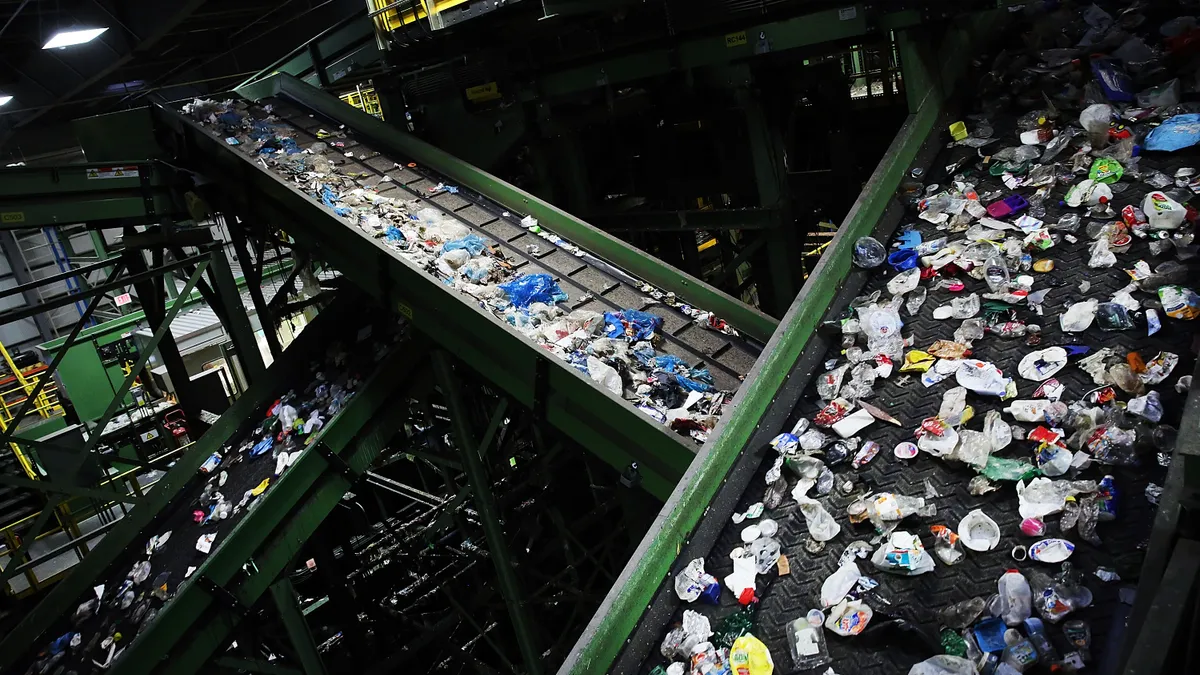Dive Brief:
- MRF operators are continuing to invest in technologies to make their operations efficient, while also adapting to the changing recycling stream, according to speakers at last week's virtual WasteExpo. Automation and advanced technologies will become even more important for facilities to remain viable and adapt to market conditions, but specific technologies and strategies will vary slightly based on facility size and type.
- Robots are now considered the hot technology, a distinction previously reserved for optical sorters. Panelists speculated about whether the industry has reached "peak optical sorter" considering modern MRFs often have several units on their sorting lines.
- Speakers also noted the value of some facilities focusing on dual-stream or becoming "boutique MRFs" that only handle specific materials. This emerging strategy is gaining popularity — especially among small MRFs — as the recycling stream rapidly changes through the introduction of new plastic packaging, diminishing use of newspapers and the receding market value of glass when collected via single-stream.
Dive Insight:
As demand increases for the industry to recycle greater volumes of increasingly complex materials, running as a boutique MRF may allow operators to specialize their facilities. That can even mean specializing in materials that previously didn't have enough market value on their own, such as polypropylene. Smaller and boutique MRFs tend to produce cleaner outputs because they don't deal with the plethora of contaminants in single stream operations, according to panelists, and demand remains higher for clean material.
"We seem to adjust as processors to what the markets are doing at any given time. If you don't, obviously there's other issues," said Brent Hildebrand, vice president of recycling at GFL Environmental. He noted some creativity is evident in the marketplace as manufacturers and processors examine the existing material mix and come up with solutions for handling it.
Municipal MRFs typically seek equipment that will last 25 to 35 years due to a long procurement process and other bureaucratic red tape, said Nat Egosi, president of RRT Design & Construction. However, private operators are more nimble and willing to adopt new technologies at a more frequent pace to keep up with a recycling stream that changes every few years, he said.
MRF technology has come a long way in 30 years, Egosi said. The recycling industry previously relied on modified equipment from other industries — such as agriculture and mining. In the 1990s, manufacturers began making equipment specifically for recycling, which helped efficiency.
"The reason optical [sorting] is so successful today is they are designed and installed specifically for our industry. And if you look at the opticals today, and you look at the ones that came in from the food industry [in the 1990s], they're night and day in performance, size, every aspect of it," Egosi said.
While optical sorters have advanced to a more developed product stage, robots and artificial intelligence are still in the nascent stages in recycling applications.
"You have things happening with artificial intelligence and robotics. We're not there yet on all fronts, but I can see where artificial intelligence might actually start monitoring things like bearing temperatures and let us know these bearings are about to go out," Hildebrand said. He anticipates more systems will add artificial intelligence technologies at the beginning of the stream and not just on the back end.
Another change occurring across the board with recycling technology involves manufacturers designing systems that can be more easily and quickly maintained to reduce down time, Hildebrand said.
The same phenomenon that happened with optical sorters is happening with robots, Egosi said. The sorting robots on the market today have hardware adapted from other industries. The current physical mechanisms are expected to evolve and fall out of favor, but the software that runs the robots will remain. He expects manufacturers increasingly will design robots specifically for use in MRFs.
"As we learn more about how they perform, the machines will be custom designed. And as the demand in the market increases, the manufacturers will respond," Egosi said.
Future robot iterations also are expected to overcome limitations with gripping and sorting capabilities that will allow them to work faster and target materials other than the container and fiber lines where they are often installed. At least for the foreseeable future, they're expected to be put on lines in series with optical sorters for optimization.
"I believe that you'll be able to see tandem robots able to handle wider belts at a little bit higher speeds than they currently do," said Chris Hawn, CEO of Machinex Technologies.











